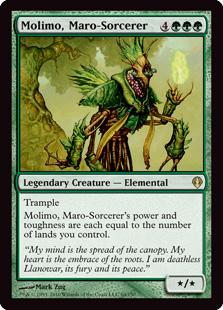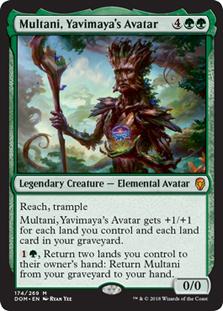For many years the oldest deck in my Commander box has been a mono-green list helmed by Molimo, Maro–Sorcerer.

Once you’ve read the card, you know basically everything there is to know about the deck. It runs a lot of lands, a lot of ramp, and a lot of gigantic threats. Molimo quickly grows bigger than whatever defenses your opponents are putting up and can easily one-shot people with commander damage, but the deck as a whole isn’t overly reliant on having Molimo in play.
Funnily enough for such a straightforward deck, it actually began as an early foray into Johnny territory. I wanted a ramp deck but knew that they had an inherent card quality problem because the ramp spells drop off in value after reaching a critical mass of lands. My solution was finding threats that gained power from having a massive number of lands in play, allowing me to run a much higher concentration of Rampant Growth effects than normal.
Since that time it’s mostly assumed the role of being a beginner-friendly deck that I can give out to new players or play myself when I get fed up with building elaborate combo engines.
The deck has remained more or less untouched for the past few years, as I’ve made changes when I found relevant cards in people’s trade binders but never went out of my way to make any sweeping changes. And then Dominaria came out, and brought this card with it:

Multani, Yavimaya’s Avatar probably didn’t mean a whole lot to most people, but he’s strictly better than Molimo in four different ways. As soon as I saw him I knew he was replacing Molimo at the helm of my deck. And that meant it was time to give my old ramp list a serious overhaul for the first time in years.
Before I get too deep into the details, here’s the decklist that I was working with at the start of the experiment.
The Deck
Commander: Molimo, Maro-Sorcerer
Creatures: Ulvenwald Tracker, Sakura-Tribe Elder, Yavimaya Dryad, Fierce Empath, Tireless Tracker, Champion of Lambholt, Farhaven Elf, Wood Elves, Dungrove Elder, Oracle of Mul Daya, Surrak, The Hunt Caller, Vizier of the Menagerie, Bellowing Tanglewurm, Acidic Slime, Vigor, Primordial Sage, Ulvenwald Hydra, Soul of the Harvest, Rampaging Baloths, Kamahl, Fist of Krosa, Spearbreaker Behemoth, Avenger of Zendikar, Archetype of Endurance, Craterhoof Behemoth, Terastadon, Genesis Hydra
Spells: Amulet of Vigor, Collective Voyage, Rampant Growth, Cream of the Crop, Nature’s Lore, Sword of the Animist, Khalni Heart Expedition, Cultivate, Strata Scythe, Bow of Nylea, Blanchwood Armor, Nissa’s Pilgrimage, Hunter’s Insight, Kodama’s Reach, Beast Within, Search for Tomorrow, Defense of the Heart, Hunting Wilds, Skyshroud Claim, Explosive Vegetation, Ranger’s Path, Garruk, Primal Hunter, Asceticism, Soul’s Majesty, Overwhelming Stampede, Nissa’s Renewal, Selvala’s Stampede, Rishkar’s Expertise, Boundless Realms, Tooth and Nail, Green Sun’s Zenith, Genesis Wave
Lands: Mosswort Bridge, Blighted Woodland, 38 Forest
While Multani is objectively more powerful than Molimo, most of the upgrades don’t change how the deck functions to the point of affecting card choices. The fact that he costs one less to cast and has reach is nice, but those improvements show themselves primarily in terms of how smoothly the deck functions in any particular game.
The one exception to this is that unlike his predecessor, Multani’s power-defining ability sees lands in your graveyard in addition to those you have on the battlefield. There’s any number of ways to take advantage of this, but I didn’t want to undermine how the deck runs by making it overly reliant on the graveyard. What I did decide to do was tweak the lands that the deck was running.
Cuts: Blighted Woodland, 17 Forest
Additions: 7 Snow-Covered Forest, Naya Panorama, Jund Panorama, Bant Panorama, Warped Landscape, Ash Barrens, Misty Rainforest, Verdant Catacombs, Wooded Foothills, Windswept Heath, Hall of the Bandit Lord
Blighted Woodland was always awkward to activate, as it costs five mana to go up one land and that’s a very costly window to find room for. Replacing it are nine lands that put themselves in the graveyard for little to no cost while replacing themselves on the battlefield. None of these are technically ramp, but they all act as an easy way to grant Multani +1/+1. What’s more, all of them are either free to activate or tap for mana, so I never have to worry about not being able to cast spells because of them.
The one utility land I’m adding is Hall of the Bandit Lord, one of the few ways to give a creature haste in mono-green. From the few games I’ve played with it so far, it’s a worthy inclusion.
The seven snow-covered forests stand out a bit. Theoretically speaking it would be correct to change all of the basic lands to be Snow-Covered, but I didn’t want to give up my favorite Forest artworks and realistically I only need there to be one Snow land in the deck for Into the North to find. The rest are just there to ensure that I don’t draw the only one by accident.
Once I decided to do a major edit of the deck, the first thing I looked at was upgrading the ramp spells. For the most part I was pretty happy with where the deck’s ramp is, but a few spells were less efficient than the rest of the deck. Farhaven Elf, Wood Elves, Sword of the Animist, Nissa’s Pilgrimage, and Ulvenwald Hydra all got cut, replaced by Far Wanderings, Harrow, Into the North, Traverse the Outlands, and Verdant Confluence. The priority here was finding the effects that find the greatest number of lands for the least amount of mana, even at the cost of giving up other effects.
By far the standout here is Traverse the Outlands. The one time I’ve cast it so far it found eleven lands and would’ve gotten more if I hadn’t run out of eligible targets in the deck.
Moving on to the non-ramp section of the deck, my first priority was eliminating cards that didn’t quite mesh with the deck’s playstyle. As an example, Soul of the Harvest and Primordial Sage had always been underwhelming in a deck that leans this heavily on creature quality rather than density. That isn’t to say that either of them are bad cards, just that this deck cannot use them to anything approaching their full potential.
Two other pieces of card advantage that never quite panned out were Vizier of the Menagerie and Genesis Hydra. The deck simply runs too many noncreature spells for Vizier to ever generate much value, while Genesis Hydra combines the worst aspects of Genesis Wave and Green Sun’s Zenith. If it could get multiple permanents out of the cards you look at like Genesis Wave or if it let you search through your entire deck like GSZ it would be well worth the slot, but with both restrictions in place it just isn’t worth it.
To replace them, Chord of Calling is a powerful toolbox effect to supplant Genesis Hydra, Greater Good can provide a massive dose of card draw whenever Multani is threatened. The other two slots were shifted over to give the deck more interaction in the form of Monstrous Onslaught and Constant Mists. The former is an incredibly powerful removal spell in a deck that’s built around having a twenty-power creature in play at all time, while the latter can entirely shut down certain linear decks and buy a lot of time against any sort of “fair” deck.
Rampaging Baloths was always a little awkward, because I wanted to play it with exactly six lands in play and profit off of every subsequent land drop, but all too often I drew it after resolving a Boundless Realms or similar effect. After going back and forth for a while the replacement card I settled on was Beacon of Creation. This might seem like an odd choice, but since the whole point of making Beast tokens is to flood the board before an Overwhelming Stampede effect the size of the tokens doesn’t really matter.
Beacon will consistently make more bodies than Rampaging Baloths and is a much more powerful draw later in the game. Since the deck wants to spend the early game ramping anyway that’s a perfect tradeoff, but it can even be useful early on if you need to buy time, and the fact that it shuffles itself into the deck means you have a high chance of seeing it again later.
The last card that I’ve had on the chopping block for a while is Dungrove Elder. While the card is individually quite powerful it’s mostly been irrelevant since the introduction of Archetype of Endurance. It’s better to have a board of threats with hexproof than to just have one, and there’s enough ways to search out specific creatures that finding it is rarely and issue.
Instead of looking for another threat I decided to turn in a new direction and introduce a recursive element to the deck in the form of Holistic Wisdom. One of the consistent themes of this deck is that certain cards don’t scale very well to the late game. While you’re still happy to cast Rampant Growth on turn twenty it doesn’t have the same impact it would’ve had on turn two. Being able to exile unneeded ramp spells in order to recur cards like Soul’s Majesty and Tooth and Nail is extraordinarily potent. Other card types will be harder to recur, but creatures and sorceries should both be easily accessible.
With all of this done I did one last search through the past several years’ worth of green cards. This is an easy step to forget, especially if you’re like me and you pour over every new set that comes out looking for cards for your decks. In this case it was worth it though, because I came across a card that I’d meant to put in the deck when it first came out, but never got around to acquiring and eventually forgot about. That card is Pathbreaker Ibex, a repeatable version of one of the most powerful Overruns effects in commander. There weren’t any other cards that I was unhappy with in the deck, so I looked at similar effects I was already running.
Craterhoof Behemoth and Overwhelming Stampede were both beyond reproach. Both are easily the most powerful finishing tools the deck has access to. Since I want Pathbreaker Ibex specifically to increase this category, cutting one of the others makes no sense.
That leaves Kamahl, Fist of Krosa. There’s a lot of similarities between the two cards. Both are repeatable engines for punching through damage, and while Kamahl has the advantage of being able to create his own army before overrunning, a single trigger from pathbreaker Ibex should be roughly equivalent to pumping twenty or more mana into Kamahl. It’s more efficient to go with the Goat.
I’ve gotten to play a few games with these changes implemented, and overall the deck plays much more smoothly than it did before. It’s much easier to curve ramp ramp spells into a six drop than it is a seven drop, and Multani routinely comes into play as a 9/9 or bigger thanks to counting the graveyard. Hall of the Bandit Lord in particular has been amazing for the deck.
I haven’t drawn some of the other new additions yet, but after I have the chance to test everything and experiment I’ll probably go through another round of edits. Probably much smaller this time though.
Levi Byrne has been with the game since Worldwake and has a rabid love for fantasy writing that goes back decades. Despite some forays into Legacy he plays Commander almost exclusively, and has a love for the crazy plays and huge games that make Magic what it is. He was the go-to advisor of his playgroup on deck construction for more than five years before joining Dear Azami.

